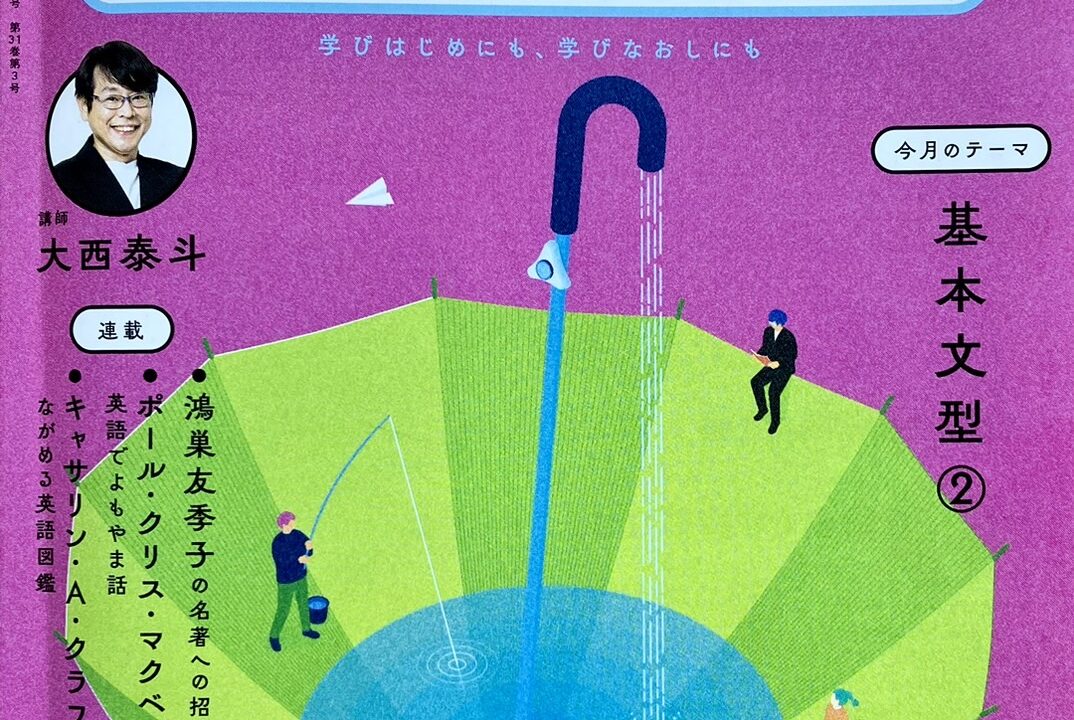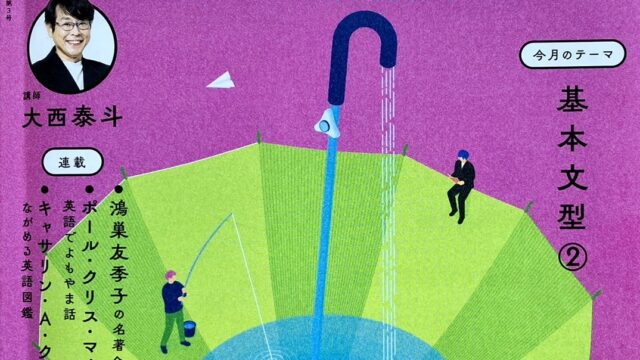June 4 Tuesday, 2024
Lesson 42 基本文型 説明型 – that節を説明語句に
☆Words & Phrases
So, your name is Stacy Lee. Any relation to Bruce Lee?
The problem is that it’s too expensive.
**worry about ~:
But you’re a rock star. You don’t need to worry about money, do you?
**The thing is that ~.:
The thing is that I don’t like paying too much for things.
**relate to ~:
Well, I can relate to that.
☆Grammar and Vocabulary
We’ve played in Hong Kong.
現在完了形のイメージ
現在完了形(have+過去分詞)が使われた文。現在完了形のイメージは「(今に)迫ってくる」この単純なイメージ がさまざまな使い方につながっている
ここでは「経験(~したことがある)」、経験を述べるとき、私たちは過去の出来事を今に「引きつけ」る。それが現在完了形が使われる理由
You don’t need to worry about money, do you?
付加疑問文
付加疑問文は軽い疑問・念押しを表す「ちょこっと疑問文」の一種
基となる文を軽い疑問文にし、文末に加える。その際、基の文と肯定・否定を入れ替える のがコツ
ここでは You don’t need ~ と否定文なので、肯定疑問「, do you?」が加えられている
肯定・否定を入れ替えるのは「~ではありません、それとも〜ですか?」と相手に選ばせる気持ちから生まれている
You don’t need to worry about money, do you?

☆Target Forms
The problem is that it’s too expensive.
説明型(SVC)は、説明語句の位置に多岐にわたる要素を自由に置くことができる
今回の文では that節が用いられている
「節」とは、主語と動詞を備え、文の部品として使われる「小さな文」のこと
そこに聞き手を「導く」感触を伴う that が加わっている
「問題はどういうことかというと、〜ということです」という文になっている
Practice
be動詞の後ろに気軽に that節を置く練習です。The problem is that ~ は、よく使われる形。(✖)A problem ~ とはならない
the を置くことによって、「最も重大な問題は、~」という意味の強調が行われている
that it’s too expensive(節)
↓
The problem is that it’s too expensive.
① The thing is that ~.
→ The thing is that ~ は「ポイントは・問題は・要するに、~」重要なポイントを指摘する言い方
② The issue is that ~.
→ issue は「(検討・議論を要する)問題(点)」
the による強調が行われている
③ The trouble is that ~.
→ trouble は「困ったこと・やっかい事」
★Practice
D: Okay everyone, it’s time for today’s practice. Here are some set phrases that we usually use in combination with that-clauses. All right, let’s master the rhythm and the feel.
**that-clauses:
R: Let’s begin!
– The thing is, The thing is
– This thing is that ~.
D: Good work. Let’s keep going,
– The issue is, The issue is
– The issue is that ~.
R: One more,
– The trouble is, The trouble is
– The trouble is that ~.
D: Unlock your potential.
R: Repetition is the key!
D&R: Great work.
☆Grammar in Action
①問題は、私たちが十分な情報を持っていないことです
**problem:
②重要な点は締め切りが明日だということです。そのときまでに、それを終えることができますか?
**deadline:
**by then:
③問題は、私が彼を知らないということです。私は彼を信じることができますか?
★Ending
O: Hey guys. “The problem is ~” and “The issue is ~”, they share the same translation sometimes, right? What’s the difference?
D: Ah, good question. See, “issues” and “problems” can both be big or small, but “problems” feel more serious, “issues” require discussion, and “problems” require solving.
R: Also, if you use the word “problem”, it does have a more negative feeling, so you can say the same kind of feeling, but if you don’t want to say anything negative, you can use the word “issue”.
June 4 Tuesday, 2024
Lesson 42 基本文型 説明型 – that節を説明語句に
(日本語訳・解説付き)
☆Words & Phrases
So, your name is Stacy Lee. Any relation to Bruce Lee?
では、あなたのお名前はステイシー・リーですね。ブルース・リーとは何か関係があるのでしょうか?
※ Any は、「何でもいいよ、どれでもいいよ」と相手に選択の自由をゆだねる単語ですね!
The problem is that it’s too expensive.
問題は、物価が高すぎることです
**worry about ~: ~を心配する
But you’re a rock star. You don’t need to worry about money, do you?
でも、あなたはロックスターです。お金のことを心配する必要はないのではありませんか?
**The thing is that ~.: 要するに〜なのです。
The thing is that I don’t like paying too much for things.
要するに、私は物にお金を払いすぎたくないんです
**relate to ~: ~に共感する
Well, I can relate to that.
そうですね、私もその気持ちはよくわかります
☆Grammar and Vocabulary
We’ve played in Hong Kong.
私たちは香港で演奏したことがあります
現在完了形のイメージ
現在完了形(have+過去分詞)が使われた文。現在完了形のイメージは「(今に)迫ってくる」この単純なイメージ がさまざまな使い方につながっている
ここでは「経験(~したことがある)」、経験を述べるとき、私たちは過去の出来事を今に「引きつけ」る。それが現在完了形が使われる理由
You don’t need to worry about money, do you?
あなたはお金を心配する必要はないですよね?
付加疑問文
付加疑問文は軽い疑問・念押しを表す「ちょこっと疑問文」の一種
基となる文を軽い疑問文にし、文末に加える。その際、基の文と肯定・否定を入れ替える のがコツ
ここでは You don’t need ~ と否定文なので、肯定疑問「, do you?」が加えられている
肯定・否定を入れ替えるのは「~ではありません、それとも〜ですか?」と相手に選ばせる気持ちから生まれている
You don’t need to worry about money, do you?

☆Target Forms
The problem is that it’s too expensive.
問題は、それが高すぎることです
説明型(SVC)は、説明語句の位置に多岐にわたる要素を自由に置くことができる
今回の文では that節が用いられている
「節」とは、主語と動詞を備え、文の部品として使われる「小さな文」のこと
そこに聞き手を「導く」感触を伴う that が加わっている
「問題はどういうことかというと、〜ということです」という文になっている
Practice
be動詞の後ろに気軽に that節を置く練習です。The problem is that ~ は、よく使われる形。(✖)A problem ~ とはならない
the を置くことによって、「最も重大な問題は、~」という意味の強調が行われている
that it’s too expensive(節)
↓
The problem is that it’s too expensive.
① The thing is that ~.
問題は、~。
→ The thing is that ~ は「ポイントは・問題は・要するに、~」重要なポイントを指摘する言い方
② The issue is that ~.
問題は、~。
→ issue は「(検討・議論を要する)問題(点)」
the による強調が行われている
③ The trouble is that ~.
困ったことに、~。
→ trouble は「困ったこと・やっかい事」
★Practice
D: Okay everyone, it’s time for today’s practice. Here are some set phrases that we usually use in combination with that-clauses. All right, let’s master the rhythm and the feel.
**that-clauses: that節
R: Let’s begin!
– The thing is, The thing is
– This thing is that ~.
D: Good work. Let’s keep going,
– The issue is, The issue is
– The issue is that ~.
R: One more,
– The trouble is, The trouble is
– The trouble is that ~.
D: Unlock your potential.
R: Repetition is the key!
D&R: Great work.
☆Grammar in Action
①問題は、私たちが十分な情報を持っていないことです
The problem is that we don’t have enough information.
**problem:(物事の達成の妨げになる)問題
②重要な点は締め切りが明日だということです。そのときまでに、それを終えることができますか?
The thing is that the deadline is tomorrow. Can you finish it by then?
**deadline: 締め切り
**by then: そのときまでに ※ by は「期限(~まで)」を表す
③問題は、私が彼を知らないということです。私は彼を信じることができますか?
The issue is that I don’t know him. Can I trust him?
★Ending
O: Hey guys. “The problem is ~” and “The issue is ~”, they share the same translation sometimes, right? What’s the difference?
D: Ah, good question. See, “issues” and “problems” can both be big or small, but “problems” feel more serious, “issues” require discussion, and “problems” require solving.
R: Also, if you use the word “problem”, it does have a more negative feeling, so you can say the same kind of feeling, but if you don’t want to say anything negative, you can use the word “issue”.
名古屋駅前にあるビジネス英語&仕事での英語雑談力をつけるための「名古屋BEGビジネス英会話ジム」
営業時間:平日 9:00~22:00 土曜日 9:00~19:00(日祝休み)
〒450-0002 愛知県名古屋市中村区名駅2丁目40-16 名駅野村ビル 5階




